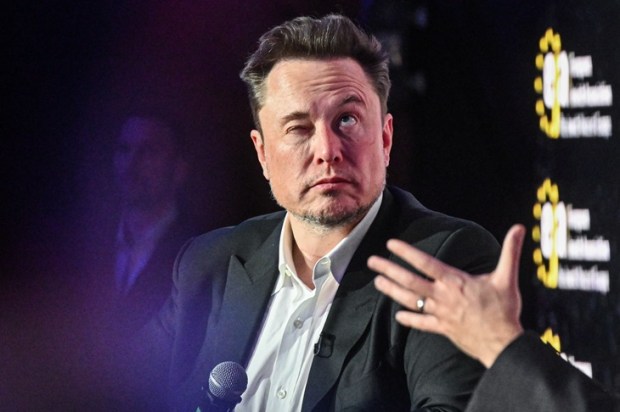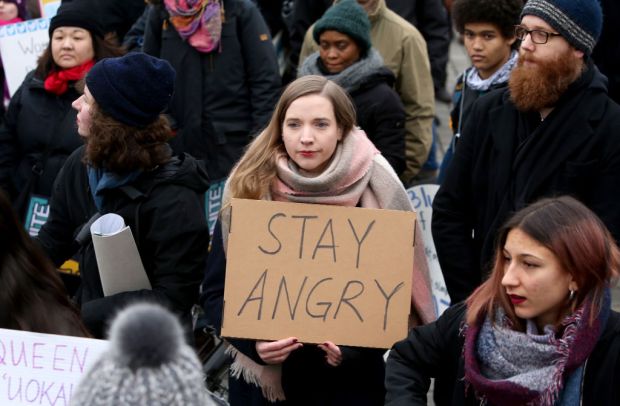Amid all the current triumphalism on the Right at how the Orange Avenger is blasting its way down the corridors of the Evil Empire of Woke, it is worth pausing to notice that there are some dark recesses of the empire that seem – thus far – likely to survive relatively intact. Among them is the empire’s ‘social justice’ laboratory where the Earth’s men and women are gradually being fused into ‘androgyns’. Let me explain…
Everyone is aware of ‘feminisation’ – the idea that the zeitgeist has seen a marked shift towards the feminine over the course of the last half century or so – succinctly defined in this essay as a societal shift ‘toward social norms centring feminine needs and feminine methods for controlling, directing, and modelling behaviour’. It is a phenomenon with huge consequences for the way we live now but one that is generally viewed in a positive light – albeit with varying degrees of enthusiasm – right across the political spectrum. But I am going to argue here that there have in fact been not one but two profound cultural shape-shifts along a masculine/feminine axis in Western society. The second shapeshift is one that I would label the Androgynisation of our culture.
This shift is much less clearly recognised, but much more insidious. It threatens to be a great leap back for mankind. But while the Right wing commentariat are busy zeroing in on the Orange Avenger’s more obvious attacks on the Empire of Woke, the puncturing and deflating of its vast Bureaucratic Blob; neutralising its human rights lawfare robocops etc etc… the Androgyny Project advances, largely unremarked. I wish I could suggest some kind of magic, Musk-like, lateral thinking that could be brought to bear in a fight back against it. But I can’t just now.
So let’s at least keep lifting the lid on it, keep it in more journalistic focus. In the late 1980s, the Chatteringclassosphere began to buzz with a new fashionable groupthink. The gist of it went something like this: the difference between men and women is not so much a case of their different biological and animal natures as something that is ‘socially constructed’. What’s more, these ‘socially constructed’ ‘gender roles’ are unnecessary and contrary to ‘progress’. As with all the other intelligentsia fads that we have endured in recent times, this ‘deconstruction’ of sex and gender first germinated in the groves of academe.
Had this ‘socially constructed gender’ theorising entered directly into the public mainstream, it would have been met with the widespread contempt and derision that it richly deserved. Or had it remained hermetically sealed in its esoteric ivory tower, no great harm to our culture need have resulted. But an academia/media nexus has become a powerful (if largely unrecognised) feature of our intellectual ecosystem. It operates like a huge agricultural spreader, spraying hyper-progressive fertiliser across the culture but in an initial concentration dilute enough for its toxicity to be unrecognised.
Radical feminism has probably always left anyone not part of the intelligentsia somewhat indifferent, at best. To most normal, largely apolitical folks, its angry, finger-wagging modus operandi will – in so far as they have encountered it – have seemed a case of throwing the Vive la Difference baby out with the bathwater. In its diluted form though, it has become the default correct-think in the entire civic, educational, and mass media environment that we inhabit. Its version of sexual equality is now pervasive in mainstream journalism and in TV drama – and is what young people are taught in schools and colleges.
Here are a few examples of Androgynisation’s downstream influence on our culture:
It is the reason why, in recent European police procedural TV crime drama, the chief cop (inevitably female) will not only have the crime-solving skills of a Sherlock but also be capable of arresting and physically subduing any violent male thug she might come up against. This despite the reality that 90 per cent of men are physically stronger than 90 per cent of women.
It is the reason why it has become ‘misogynistic’ – in polite Progressive society – to notice certain job-market realities. Yes some women would make great security guards just as some men would make great midwives … just not that many. Also, women can be great leaders and chief executives but almost certainly fewer of them than men actually want this kind of role.
More indirectly, it is the reason why ‘trans’ mania has coursed its way through our political and cultural system at Mach speed; accelerating from something of zero interest to 99 per cent of people to an urgent, primary political and managerial ‘issue’ in the space of just a few years.
Worst of all has been its joyless attack on normal sexuality. Of all the Orwellian Newspeak terms we have allowed to infiltrate the language, ‘heteronormative’ must rank as one of the most poisonous. It is an insidious assault on what is likely the greatest joy in the average person’s life. In political correct-think, the sexuality of the 95 per cent has been relativised as ‘straight’ or prefixed with ‘cis’. Tristan and Isolde, Paris and Helen of Troy, Miss Bennet and Mr Darcy, John boy Walton and Jenny; iconic romances now cast into one great ‘non-binary’ cultural jamboree bag.
Then there is the androgynous online youth culture of ‘anime’ and ‘manga’. To a boomer like me it seems something from another planet but this Unherd piece portrays its teenage Miss Havisham ‘bedroom-bound dreamworld … [of] undersexed disciples’. It makes 80s goths seem almost ‘summer camp’ by comparison.
I have deliberately held back from a foray into the philosophical roots of Androgynisation until after the above discussion of its effects so as to not get side-tracked by its quintessentially bogus mind games. I find Third Wave Feminist word salads so perverse as to almost defeat my ability to form sentences about them and so am grateful to dissident feminist philosopher Kathleen Stock for this succinct summary:
‘In radical feminist Utopia, we’re told, there will be “gender abolition”… the complete destruction of, and liberation from, feminine and masculine cultures … there will be males and females … but no cultural behaviours distinctively associated with the two different kinds of body … the most egregious examples of this disassociation are found in third wave feminists and queer theorists … who attribute such extraordinary powers to the human psyche they apparently think the mind can dismantle nature by the power of words … in other words: Fight the musculoskeletal system!’
When I was a young man, the essential nature of masculinity and femininity was not particularly in doubt. It did not need debating in academic papers nor even talking about, except perhaps in novels. Then, in the late 20th Century, Feminism (like some other political causes) got caught up in the post-60s radical-progressive capture of intellectual discourse. And it began to spin off from its original project – as a corrective to the power imbalance between men and women – to something else entirely.
It seems to me that the most completely defining experience in life – more defining than the culture one was born into; more than whether born rich or poor – is whether one was born a boy or a girl. By ‘defining’ I don’t mean in the sense that a feminist might mean it; I mean in the sense of the sheer imaginative leap it would take to know what it feels like to be the opposite sex. I have only ever managed the sketchiest of glimpses no matter how hard I may have tried. There’s not much positive that can be said about Mao Zedong but his famous ‘Women hold up half the sky’ beautifully expresses a profound truth about the bond between the male and female halves of humanity … a bond that transcends any other kind; ideological, tribal or otherwise.
There are now very few Westerners who would demur from the idea of womanhood as being on an equal footing with manhood and 20th Century. Feminism can be credited with helping to bring this about. Most people would, I think, view it as a necessary societal correction that has taken place. Many perhaps also think of it as an over-correction. They think that these gains could surely have been secured without the later joyless assault on normal sexuality that ‘Third Wave’ dysphoric blah blah represents. (Perhaps it is the destiny of all activist movements to eventually be hijacked and driven off course by unrepresentative obsessives and malcontents.)
Pretty young women do not wear short skirts and high heels because of ‘patriarchy’ but because they feel their femininity thereby enhanced. Young men wolf whistling at them is the opposite of ‘misogyny’. Seeking the ‘male gaze’ is (like its sister the female gaze) the primary driver of the trillion-dollar female adornment industry. When gentlemen hold the door for ladies it is not to ‘control’ but to charm. No, of course women shouldn’t ever have to be the object of unwanted male predation but young women do naturally tend to like being the object of male desire. Seeking to excise these expressions of la différence from the human condition merely serves to leave it fractious and immiserated.
I often read about the ‘global fertility crisis’. Its causes are clearly complex and multi-dimensional but could it be that Androgyny Syndrome is one of them? As G. K. Chesterton observed a hundred years ago: ‘When all are sexless there will be equality. There will be no women and no men. There will be but a fraternity, free and equal. The only consoling thought is that it will endure but for one generation.’

























